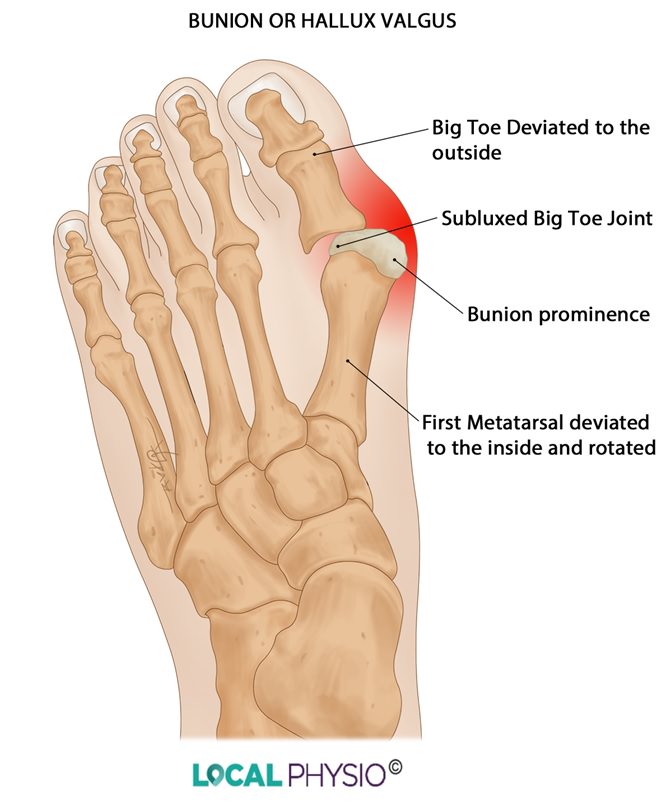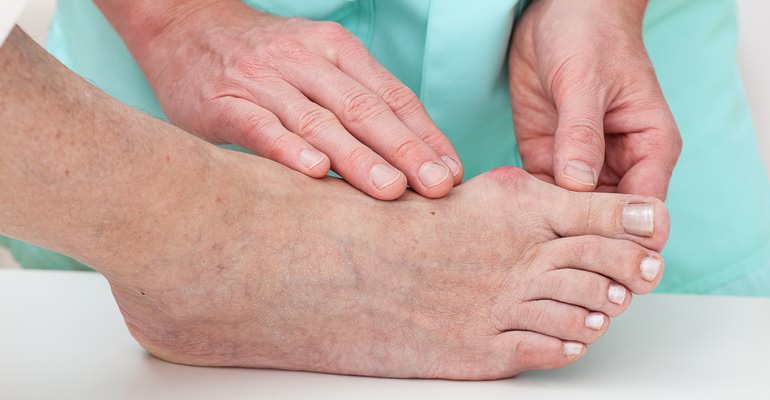What Is A Bunion?
A bunion, known medically as hallux valgus, is a common foot deformity indicated by a large lump on the inside of the big toe. The resulting big toe pain and foot pain can give problems walking and in finding comfortable shoes.
A bunion is a complex deformity involving the inner side of the foot and not just a lump forming on the lower big toe joint. It involves:
- The big toe moving outwards towards the other toes and rotating
- The first metatarsal moving inwards
- The development of a prominent lump over the lower big toe joint
Hallux is the Latin for big toe and valgus refers to the tendency for the big toe to move away from the centre towards the outside, the equivalent anatomically of knock-knee.
Anatomy Of The Foot
The most obvious change in a bunion is a gradual abnormality of the big toe joint, but this condition also involves the first metatarsal bone and the bones of the mid-foot and hind-foot. The complex nature of this condition means that treatment is not a straightforward matter.
- The ligaments on the inner side of the big toe joint weaken and it starts to move outwards towards the other toes.
- The abnormal pull on these ligaments can cause bone formation on the side of the joint and the lubricating bursa over the inner side of the joint may also thicken.
- The muscles attached to the big toe may pull it further into a poor position once the toe has moved across enough.
- The first metatarsal bone adducts (moves towards the centre), moves upwards and rotates, stressing and damaging further the joint capsules and surrounding ligaments.
- The big toe may then overlap or underlay one or more of the outer toes.
- Many other changes can occur in the foot joints surrounding the main affected areas.
What Causes Bunions?
Bunions are more common in women, women who wear high heels and women whose shoes are too narrow. In men they are more common if they have flat feet or are overweight. If children have shoes that are too small this increases the risks also.
High heel shoes or tight shoes do not cause hallux valgus as such, but may contribute to the foot stresses which occur in people who are at risk of developing bunions.
Instability of the foot is one of the major factors:
- The soft tissues such as ligaments or fascia may be tight or hypermobile
- Foot joints may be in abnormal positions
- Flat feet may be present
- Joint mobility may be restricted.
All these factors can contribute towards the foot being unable to transmit the forces of the body weight normally and stress the forefoot structures, leading to the formation of a bunion.
Medical conditions can also contribute to hallux valgus including rheumatoid arthritis, gout, psoriatic arthritis and connective tissue conditions such as hypermobility, Marfan syndrome, Down syndrome and Ehlers-Danloss syndrome. Neuromuscular diseases such as MS and cerebral palsy may also contribute.
Genetic factors are known to be important as many sufferers have relatives with the same problem.
Who Gets Bunions?
Bunions are much more common in women, perhaps four times so, but this may depend partly on the type of shoes worn. Women between thirty and sixty years of age are most likely to develop a bunion, although the process may have begun many years earlier.
How many people get bunions is not clear although the incidence appears to increase with age.
Presentation
Patients can present with different symptoms at different times. A bunion may develop without symptoms initially, then begin to ache on walking and worsen. A sharp pain occurring on walking in the main big toe joint may point towards arthritic changes in that joint.
If aching occurs on walking and is better when shoes are removed then the diagnosis may be “bump pain” from pressure on the lump that has formed on the inside of the joint. Tingling or burning on the top of the joint may indicate one of the small nerves is compressed and irritated.
Investigations For Bunions
X-rays are the main investigation for this condition and surgeons can measure a series of angles between the joints and the bones. This gives them a picture of what is going on amongst the complex changes in the foot mechanics.
Bunion Treatment
Initial management of a bunion is to minimise anything that is contributing to the deformity. A physiotherapist or a podiatrist can advice on a variety of issues including footwear, stretching of tight structures and exercises.
Footwear Adaptation
Shoes can be stretched over the prominent joint to reduce pressure and shoes with a deeper toe box (top to bottom). Strapping, taping and padding can be used to relieve shoe pain problems where other treatment is not forthcoming, but tend not to be very effective.
Drugs For Bunions
Steroid injections into the large big toe joint may be used to settle down severe and sudden onset pain.
Physiotherapy For Bunions
Physiotherapy has a role in the treatment and management of hallux valgus. A full assessment of the lower leg biomechanics can be useful to identify stiff joints and soft tissues or weak muscles. Stretching, muscle strengthening and gait correction may all be useful.
Orthotics
If the changes in the foot are not too advanced or too rigid, an insole may be used to move the affected area back towards a pain-free and neutral position. Once the foot has been assessed, an orthotist, podiatrist or physio may prescribe ready-made or custom-made orthotic insoles. Individual corrective parts can be placed under the forefoot or hind foot to correct specific abnormalities of foot posture.
Bunion Surgery
Operation can improve pain, appearance and functional ability but even good surgery may leave a third of patients with some kind of limitation. This can include a persistent bunion, pain and stiffness.
The commonest operations are:
- Keller procedure, for older people with advanced joint damage and poor joint range
- Chevron osteotomy to re-align the first metatarsal in mild to moderate hallux valgus
- Fusion of the main big toe joint, for people who have high activity levels and advanced joint changes.
There are a large number of other operations to address the complex nature of this condition.
References:
Bunion. NHS Choices. http://www.nhs.uk/conditions/Bunion/Pages/Introduction.aspx
Hallux valgus. Medscape. http://emedicine.medscape.com/article/1232902-overview
Bunions. The College of Podiatry. http://www.scpod.org/foot-health/common-foot-problems/bunions/
Last Review Date: 08-12-2019
Next Review Date: 08-12-2021


